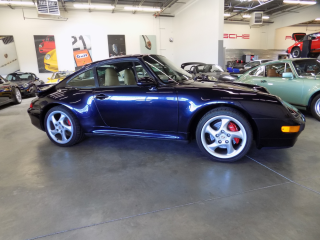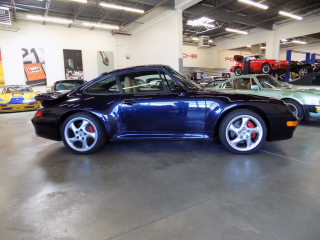The Good
The 1996 Porsche 911 (993) offers thrilling air-cooled performance with superb handling, appealing to emotional drivers. Its robust engineering ensures impressive long-term reliability for practical buyers. The timeless design and surprisingly comfortable interior enhance its appeal. While not overly efficient, its strong value retention and appreciation make it a sound investment, balancing passion with financial prudence.
The Bad
Known weaknesses for the 1996 Porsche 911 (993) include potential for oil leaks (especially rear main seal and valve covers), aging suspension components requiring replacement, and costly parts and specialized labor for maintenance. The air conditioning system can also be a weak point, and early OBD-II issues might arise.
1996 Porsche 911: Quick Overview
- Engine Options: All 3.6-liter air-cooled flat-six engines.
- M64/05/06 (Varioram) for Carrera, Targa, Carrera 4, Carrera S, Carrera 4S.
- M64/60 (twin-turbocharged) for the 911 Turbo.
- Horsepower:
- Carrera/Targa/Carrera 4: 282 hp (with Varioram).
- Carrera S/Carrera 4S: 282 hp.
- 911 Turbo: 400 hp.
- 911 GT2: 430-450 hp (limited production, RWD variant of the Turbo).
- Fuel Economy: Varies by trim and transmission, generally in the range of 17-23 MPG combined. Requires premium unleaded fuel.
- 0-60 MPH Times:
- Carrera (manual): Approximately 5.3-5.5 seconds.
- Carrera 4 (manual): Approximately 5.2-5.4 seconds.
- 911 Turbo: Approximately 4.2-4.4 seconds.
- 911 GT2: Approximately 4.0 seconds.
- Towing Capacity: Not applicable for this performance-oriented sports car.
- Trim-Level Features:
- Carrera (C2): Rear-wheel drive, 282 hp, available with 6-speed manual or 4-speed Tiptronic S automatic transmission. Standard luxury and performance features for the era.
- Carrera 4 (C4): All-wheel drive, 282 hp, visually similar to C2 but with AWD badging and slightly wider rear track.
- Carrera S (C2S): Rear-wheel drive, 282 hp, features the wider body of the Turbo/C4S, sport suspension, and upgraded wheels.
- Carrera 4S (C4S): All-wheel drive, 282 hp, boasts the iconic wide body of the Turbo, along with Turbo-spec brakes and suspension for enhanced performance and aesthetics.
- Targa: Unique sliding glass roof panel, RWD, 282 hp, offering an open-air experience distinct from the Cabriolet.
- 911 Turbo: All-wheel drive, 400 hp twin-turbo engine, distinctive fixed rear wing, wide body, and upgraded braking system.
- 911 GT2: Extremely rare, RWD, highly tuned turbo engine, stripped-down interior, aggressive aerodynamic package for track performance.
1996 Porsche 911 Specifications
Vehicle Information
| Year | 1996 |
| Make | Porsche |
| Model | 911 |
| Trim | - |
| Style | - |
| Type | Coupe |
| Category | Compact Car |
Manufacturing Details
| Made In | Germany |
| Manufacturing City | - |
Dimensions
| Doors | - |
| Curb Weight | - |
| Gross Vehicle Weight Rating | - |
| Overall Height | - |
| Overall Length | - |
| Overall Width | - |
| Wheelbase Length | - |
| Standard Seating | - |
Engine & Performance
| Engine | 3.6 L 6-Cyl. |
| Engine Size | 3.6L |
| Engine Cylinders | 6 |
| Transmission | - |
| Transmission Type | - |
| Transmission Speeds | - |
| Drivetrain | - |
Additional Features
| Anti-Brake System | - |
| Steering Type | - |
Pricing
| Manufacturer Suggested Retail Price (MSRP) | - |
| Invoice Price | - |
| Delivery Charges | - |
Vehicle History Report
Specifications
History
Events
History Check
Check
Check
Check
Check
Listings
Recalls
Check
Analysis
What Problems Does the 1996 Porsche 911 Have?
The heating and air conditioning systems are another common area for concern. Issues range from failing blower motors and control units to simply weak cooling performance due to aging components. Suspension components, including bushings and shock absorbers, will inevitably wear out over 25+ years and require replacement to maintain the car's legendary handling.
Power steering pump leaks can also occur, and clutch wear is a natural consumable for manual transmission cars. Exhaust manifold studs are prone to breaking due to thermal cycling and corrosion, leading to exhaust leaks. Minor electrical gremlins can manifest in aging window regulators, central locking systems, and occasional pixel degradation in the instrument cluster. For 1996-1998 Carrera models featuring Varioram, while generally reliable, the vacuum lines and actuators can degrade, potentially impacting performance.
Recalls for the 993 generation were relatively rare and often minor, focusing on specific safety components rather than widespread mechanical flaws. Official NHTSA databases can provide precise details. Long-term reliability concerns mostly revolve around the degradation of rubber and plastic components due to age and heat cycling, as well as the high cost of replacement parts and specialized labor when major components eventually need servicing. Rust can be a concern in neglected areas, particularly around the windshield frame and lower door sills, if not properly cared for.
How long will the 1996 Porsche 911 last?
Long-term weaknesses primarily involve the natural degradation of perishable components. Rubber seals, bushings (e.g., suspension, engine mounts), and interior plastics will eventually stiffen, crack, or fail due to age and exposure. Electrical components like window regulators and switches can also become intermittent. Neglecting regular oil changes and addressing minor oil leaks can lead to more significant issues over time. While the core mechanicals are incredibly strong, proactive replacement of these age-related items is crucial to preserve its legendary durability and prevent expensive secondary damage.
What Technology & Safety Features are Included?
Built-in Tech & Entertainment: The cockpit features classic analog gauges, with some models offering a basic On-Board Computer (OBC) displaying rudimentary trip information and external temperature. For entertainment, standard offerings typically included a basic AM/FM radio with a cassette or CD player (often Becker or Alpine units) and a 6-speaker sound system. An optional "Hi-Fi" sound system with an amplifier and upgraded speakers was available for audiophiles.
Driver-Assistance & Safety Features: Modern driver-assistance systems were non-existent. However, the 993 was equipped with essential safety features for its time. These included standard Anti-lock Braking System (ABS) for improved stopping performance, power steering, and a robust impact-absorbing body structure. Driver and passenger airbags were standard, along with 3-point seatbelts with pre-tensioners. Traction control (ASR) was an optional feature, sometimes bundled with all-wheel-drive models. Porsche Stability Management (PSM) had not yet been introduced. The powerful disc brakes on all four wheels (vented and cross-drilled on higher trims like the Turbo/C4S) provided excellent stopping power.
Optional Features: Buyers could personalize their 993 with numerous options, including full leather interior upgrades in various colors, sport seats, an electric sunroof, cruise control, a rear window wiper, automatic climate control (upgrading from manual), headlight washers, and Porsche's 4-speed "Tiptronic S" automatic transmission. Aerodynamic kits (e.g., front spoiler, rear wing) and larger 17-inch or 18-inch wheels were also popular choices.
Crash-Test Ratings: Official crash-test ratings from organizations like NHTSA or IIHS are generally not available for vehicles of this era, particularly for low-volume, specialized sports cars. The 993 met the prevailing safety standards of its production years, but its design predates modern, comprehensive crash-testing protocols and scoring systems.
What Colors Options are Available?
1996 Porsche 911 Prices and Market Value
This indicates a unique depreciation insight: the 993 has become a strong appreciating asset. Factors heavily affecting resale value include the vehicle's overall condition, a complete service history, originality (unmodified examples are prized), the specific trim level (Turbo, GT2, C4S are top-tier), manual vs. Tiptronic transmission (manuals are more desirable), and desirable factory color combinations. Low mileage examples in pristine condition command premium prices.
1996 Porsche 911 Cost of Ownership
Maintenance and repair costs are high. Parts are expensive, and specialized Porsche labor rates are premium. Expect to budget for proactive replacement of aging components like suspension bushings, seals, and hoses. While the vehicle is reliable, when significant repairs are needed, they are substantial. This is a passion purchase, and prospective owners must be prepared for the financial commitment required to maintain this appreciating classic.
1996 Porsche 911 Fuel Efficiency
1996 Porsche 911 Recalls & Defects
AIR Bags:frontal
Engine and Engine Cooling:exhaust System:manifold/Header/Muffler/tail Pipe
Engine and Engine Cooling:cooling System
1996 Porsche 911 Insurance
reasonable repair costs.
How Does the 1996 Porsche 911 Compare to Other Coupe?
Performance: The 993 offers a superb balance of communicative handling, direct steering, and a potent air-cooled flat-six. While a Ferrari F355 might offer a more exotic, high-revving V8 soundtrack and slightly quicker acceleration (especially the GTS), the 993 provides a more robust and arguably more usable daily performance. The Acura NSX focused on surgical precision and everyday usability but lacked the raw power of the 993 or F355. The BMW E36 M3 was a fantastic sport sedan/coupe but operated in a lower performance tier, while the C4/C5 Corvette offered immense straight-line power for the money but often lagged in interior quality and chassis refinement compared to the Porsche.
Features: The 993 was driver-focused with minimal modern tech, prioritizing mechanical feel. Its interior was well-appointed for its time. The NSX offered more Japanese-style creature comforts, while the Ferrari was more spartan. The M3 and Corvette, while capable, often felt less premium in their cabins.
Reliability: This is where the 993 truly shines against its direct exotic rivals. It's famously robust, especially compared to the F355, which is notorious for expensive engine-out belt services. The NSX also enjoys a reputation for excellent reliability, rivaling the Porsche. The M3 and Corvette were generally reliable for their price points.
Price: New, the 993 occupied a mid-to-high position, above the M3/Corvette/NSX, but below the F355. Today, however, the 993 has seen significant appreciation, with many variants (especially Turbo, C4S) now commanding prices often higher than the F355, and substantially more than the M3 or C4/C5 Corvette. NSX values have also soared but generally remain below top-tier 993s.
Alternatives:
- Similar (modern alternative): A Porsche 997 Carrera offers a more modern, water-cooled experience with contemporary safety and tech, potentially at a lower entry cost, while retaining the essential 911 driving dynamics.
- Similar (classic alternative): The Porsche 964, the 993's predecessor, is also air-cooled, offering a rawer, more analog experience and a slightly lower cost of entry, though its values are also appreciating rapidly.
- Budget performance: BMW Z3 M Coupe/Roadster or a C5 Corvette offer compelling performance for significantly less investment, though without the same classic Porsche prestige or investment potential.
Final Verdict: Is the 1996 Porsche 911 a Good Coupe?
Prospective owners should exclusively look for used models, as new ones are long gone. The most crucial condition is finding a well-documented example with a comprehensive service history and undergoing a thorough pre-purchase inspection (PPI) by a reputable Porsche specialist. Be prepared for high long-term ownership costs; this is not a budget vehicle. While the Carrera trims offer an excellent entry point into the 993 experience, the C4S and Turbo models provide enhanced performance and exclusivity at a much higher premium. Manual transmissions are generally preferred for driving engagement and resale. This car is not for those prioritizing modern technology, ultimate comfort, or low running costs, but rather for the profound joy of driving a legendary, meticulously engineered machine.

